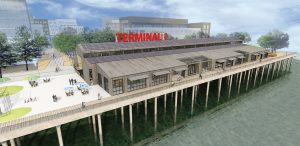City code changes help solidify vision for Port of Vancouver’s Terminal 1
Shoreline Master Program amended to allow public marketplace over water
 The Port of Vancouver USA has been planning its waterfront redevelopment – Terminal 1 – for more than five years. The port’s vision for this unique site includes a hotel, retail, offices, public spaces and art, and – perhaps the most popular feature – a public marketplace over the Columbia River.
The Port of Vancouver USA has been planning its waterfront redevelopment – Terminal 1 – for more than five years. The port’s vision for this unique site includes a hotel, retail, offices, public spaces and art, and – perhaps the most popular feature – a public marketplace over the Columbia River.
But the devil is in the details. One detail in particular could have put this vision at risk: The city’s Shoreline Master Program (SMP), which governs activities along the shoreline, required that structures over the water needed to have water-dependent use, such as shipping.
From shipping to recreation
The 1920s Terminal 1 warehouse sat on a working dock until the late 1950s, when the dock had to be shortened to accommodate the newly built, southbound span of the Interstate 5 Bridge. The dock could no longer support ocean-going vessels and the property became a commercial site, housing restaurants and lodging for nearly 60 years.
As the port began working on plans to replace the century-old dock and move the Terminal 1 building to accommodate a future I-5 bridge, a conflict became clear: While replacement of the dock would likely have complied with city code, reconstructing a new Terminal 1 building west of the existing building would not, because it would not have been a water-dependent use.
Knowing the value of an overwater public marketplace at Terminal 1, port staff, consultants BergerABAM and city planners worked together to amend the city’s SMP. Working closely with the Washington State Department of Ecology, the city added two key pieces and amended a third piece in its SMP to allow for specific water-related and water enjoyment structures in the aquatic designation covering the Columbia River between the I-5 and BNSF Railway bridges.
City code now allows for future construction of the public marketplace as envisioned in the port’s plans: a warehouse-like structure built on a new dock over the Columbia River, so locals and visitors alike can access the river and enjoy one of the most unique and well-loved amenities in our region.
City, port partnership
Port staff expressed their appreciation for the City of Vancouver’s partnership and dedication to supporting a grand, community-focused vision for Terminal 1 and the downtown Vancouver waterfront.
“I really appreciate the support from the city, Ecology and BergerABAM, and Matt (Harding) leading those efforts,” said port CEO Julianna Marler. “It’s a great vision, and…without everybody’s work, we wouldn’t have the approval to move forward.”
“This was a really great partnership with the city on getting this approved,” said port Environmental Project Manager Matt Harding. “The city didn’t have to do this. It showed their commitment to this project and…all of our community’s vision for this downtown waterfront.”
Next steps
These changes to the SMP require amendments to the port’s Terminal 1 Concept Development Plan, which was approved by City Council in June 2017. The port and city will continue working together to amend the plan.
Meanwhile, the port continues seeking funding for the entire Terminal 1 development, which is estimated to cost $80 to 100 million to fully develop. Ground stabilization and the first phase of work on the Renaissance Trail are moving forward this summer. T1 Hotel, which is building an AC by Marriott lifestyle hotel at Terminal 1, is finalizing its design and preparing for construction in 2019.
Visit www.portvanusa.com/key-projects/waterfront-project for more information on Terminal 1, including animated visualizations, potential marketplace features and how to partner with the port on this exciting development.
